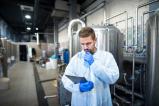Cleaning and Sanitizing in the Food Industry
By Business Training Media
Cleaning and sanitizing are crucial steps in ensuring food safety in the food industry. Proper cleaning and sanitizing help prevent the spread of bacteria, viruses, and other harmful pathogens that can cause foodborne illnesses. In this article, we will discuss the importance of cleaning and sanitizing, the difference between cleaning and sanitizing, and the best practices for cleaning and sanitizing in the food industry.
Importance of Cleaning and Sanitizing
The food industry is a high-risk environment for the spread of harmful pathogens. Food can be contaminated at any stage of production, processing, or handling. Bacteria, viruses, and other pathogens can survive and thrive on surfaces and equipment in the food industry and can easily spread from contaminated surfaces to food products. These pathogens can cause foodborne illnesses, which can have serious health consequences, including hospitalization and even death.
To prevent the spread of harmful pathogens, it is essential to implement effective cleaning and sanitizing procedures in the food industry. Proper cleaning and sanitizing can help to remove and kill harmful pathogens on surfaces and equipment, preventing their spread to food products and reducing the risk of foodborne illnesses.
Difference between Cleaning and Sanitizing
Cleaning and sanitizing are often used interchangeably, but they are two distinct processes that serve different purposes.
Cleaning refers to the removal of visible dirt, debris, and other contaminants from surfaces and equipment. This is typically done using soap, water, and a scrub brush. Cleaning helps to physically remove harmful pathogens from surfaces and equipment, reducing the number of bacteria and other contaminants present.
Sanitizing refers to the reduction of harmful pathogens on surfaces and equipment to safe levels. This is typically done using a chemical sanitizer, such as chlorine or quaternary ammonium compounds. Sanitizing helps kill harmful pathogens that may remain on surfaces and equipment even after cleaning, reducing the risk of foodborne illnesses.
Best Practices for Cleaning and Sanitizing in the Food Industry
1. Develop and Implement Standard Operating Procedures (SOPs)
To ensure consistent and effective cleaning and sanitizing, it is important to develop and implement standard operating procedures (SOPs). SOPs should outline the specific steps for cleaning and sanitizing each area of the facility, as well as the frequency of cleaning and sanitizing.
2. Train Employees on Proper Cleaning and Sanitizing Procedures
All employees should receive training on proper cleaning and sanitizing procedures, including the use of chemicals, equipment, and personal protective equipment (PPE). Training should be ongoing and provided to new employees, and refresher training should be provided to existing employees.
3. Use the Right Cleaning and Sanitizing Chemicals
The right cleaning and sanitizing chemicals should be used for each area of the facility, based on the type of surface or equipment being cleaned or sanitized. Chemicals should be used according to the manufacturer's instructions and should be properly diluted.
4. Use Proper Equipment and Tools
The right equipment and tools should be used for each area of the facility, including scrub brushes, mops, and cleaning cloths. Equipment and tools should be properly maintained and stored to prevent contamination.
5. Follow Proper Cleaning and Sanitizing Procedures
Proper cleaning and sanitizing procedures should be followed for each area of the facility. This includes following the correct order of cleaning and sanitizing, allowing proper contact time for the sanitizer, and allowing surfaces and equipment to air dry.
6. Conduct Regular Inspections and Audits
Regular inspections and audits should be conducted to ensure that cleaning and sanitizing procedures are being followed correctly and consistently. Inspections and audits can identify areas for improvement and help prevent contamination.
7. Document Cleaning and Sanitizing Activities
All cleaning and sanitizing activities should be documented, including the date, time, and person responsible. Documentation can help ensure that cleaning and sanitizing procedures are being followed correctly and consistently. It can also serve as evidence of compliance with food safety regulations and help identify areas for improvement.
8. Use Personal Protective Equipment (PPE)
Personal protective equipment (PPE) should be worn when cleaning and sanitizing, including gloves and eye protection. PPE helps protect employees from harmful chemicals and pathogens, reducing the risk of injury or illness.
9. Follow Regulatory Requirements
The food industry is heavily regulated, and it is important to follow all regulatory requirements related to cleaning and sanitizing. This includes following the requirements for chemical concentrations, contact time, and temperature.
10. Implement a Verification Program
A verification program should be implemented to ensure that cleaning and sanitizing procedures are effective in reducing the risk of contamination. This can include testing surfaces and equipment for pathogens or conducting environmental monitoring to identify areas of potential contamination.
Final thoughts
Cleaning and sanitizing are critical steps in preventing the spread of harmful pathogens in the food industry. Proper cleaning and sanitizing can help remove and kill harmful pathogens on surfaces and equipment, reducing the risk of foodborne illnesses. To ensure effective cleaning and sanitizing, it is important to develop and implement standard operating procedures, train employees on proper procedures, use the right chemicals and equipment, follow proper procedures, conduct regular inspections and audits, document activities, use PPE, follow regulatory requirements, and implement a verification program.
By following these best practices, the food industry can help ensure the safety of the food supply and protect the health of consumers.
Copyright 2023: Business Training Media
Join Our Free HR Training Solutions eNewletter
Join our free HR Training Solutions eNewsletter today to stay up-to-date on the latest industry trends, training and development programs, best practices, and expert insights. Gain valuable knowledge, enhance your skills, improve your organization, build productive teams and elevate your career. Don't miss out on this invaluable resource – sign up now for our free HR Training Solutions eNewsletter!

Cleaning and Sanitizing in Food Processing and Handling Environments Part I: Cleaning
Employees who work with food need to be committed to creating products that are safe to eat. So it's important that they follow good cleaning procedures in their facility.




